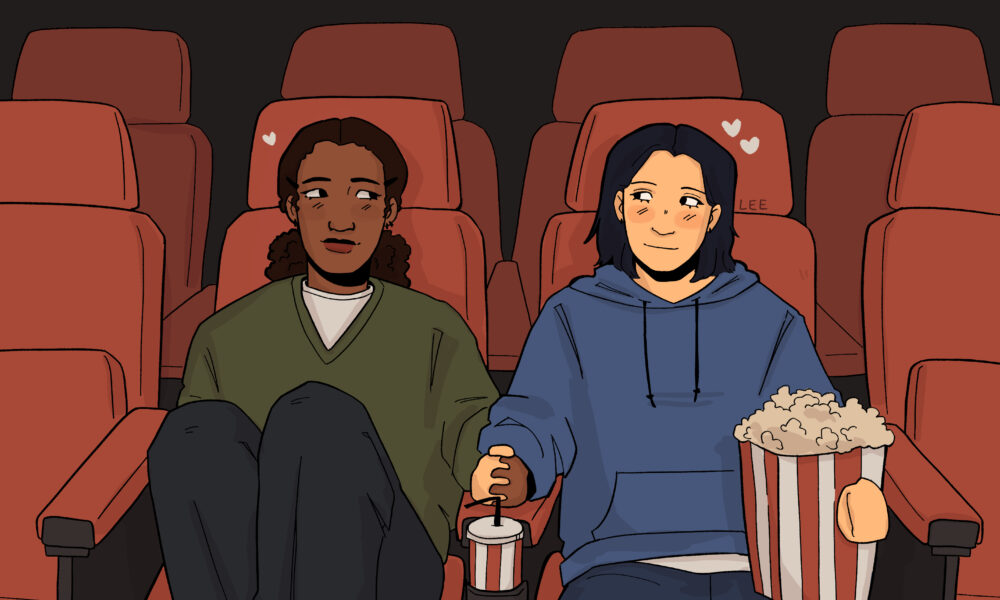From boxers to bodybuilders to road trippers and beyond, the past six months have given us an unprecedented number of movies about queer women. As slow, candlelit period pieces fueled by stolen glances, often the sole lesbian representation in media, feel increasingly outdated, this new “golden age” presents an exciting prospect in terms of representation. Films about queer women are expanding in scope, genre, and number, marking a sharp contrast with their television counterparts, which often face cancellation after just one or two seasons.
A film that could be credited with bringing lesbian cinema to the mainstream is Bottoms. Apart from its incredible script, hilarious antics, and revival of the raunchy teen comedy genre that has been largely absent but sorely missed, the primary draw of the movie lies in its co-leads: Ayo Edebiri and Rachel Sennott. Both breakout stars in their own right, they seem to stand as role models for a younger, predominantly women, queer audience, as well as leaders in a comedy space that hasn’t always been so welcoming to them. Though this trend of genre reclamation and revitalization is particularly evident in Bottoms, it can easily be applied to the success of other recent mainstream movies about queer women as well.
Sapphic stories on the silver screen have also seen a remarkable genre expansion as of late. From road trip movies to neo-noirs, the first few months of 2024 have seen delightfully messy interpretations of lesbian relationships onscreen. Drive Away Dolls is unabashedly raunchy and unafraid to depict lesbian women fully in control of their sexuality, as opposed to continually struggling with some sort of repressed desire. By allowing the characters to freely explore and express their sexuality without being a side plot to a separate heterosexual storyline, a certain level of authenticity shines through in the way these women communicate, engage with, and relate to one another. Moreover, by using genres that are not often explored in queer cinema, like mob movies, the screenwriters can effectively exploit the differences that a diverse perspective brings to a tired or worn-out genre.
In a similar vein, Rose Glass’s Love Lies Bleeding, starring Kristen Stewart (Lou), revitalizes the genre of noir filmmaking from a lesbian character’s perspective. Both Stewart and Glass have spoken about not using a coming-out narrative, favouring genre-based elements instead. Drive Away Dolls and Love Lies Bleeding use this decentring of identity to seamlessly integrate representation into these often violent and grotesque genres. The result is media creation that allows queer women viewers to connect with a story based on their identity while still enjoying the particularities and tropes of a specific genre.
While movies featuring lesbian characters are succeeding at the box office and online, their television counterparts, like Amazon Prime’s A League of Their Own or Netflix’s First Kill, are frequently axed after just one or two short seasons. Showrunners consistently push forward shows featuring gay men as critical darlings and beacons of diversity, while they often sideline lesbian women even in conversations about representation within the 2SLGBTQIA+ community. Many of these shows have passionate and young online fanbases, leading media critics to take them less seriously. Consequently, these shows are deprioritized both in terms of awards and finances, making them first on the chopping block when it comes time for renewal. Lesbian films can operate under the umbrella of high art, slipping by under the guise of subversion, whereas lesbian TV shows, with all their glorious authenticity, are more vulnerable to criticism.
It has undoubtedly been an incredible year for queer women in film, and hopefully, it sets a precedent that allows more young queer women to develop stories and characters that reflect their lived experiences. It would be fantastic if the success of queer women in film could help propel sapphic-centred TV shows into second seasons and beyond.








